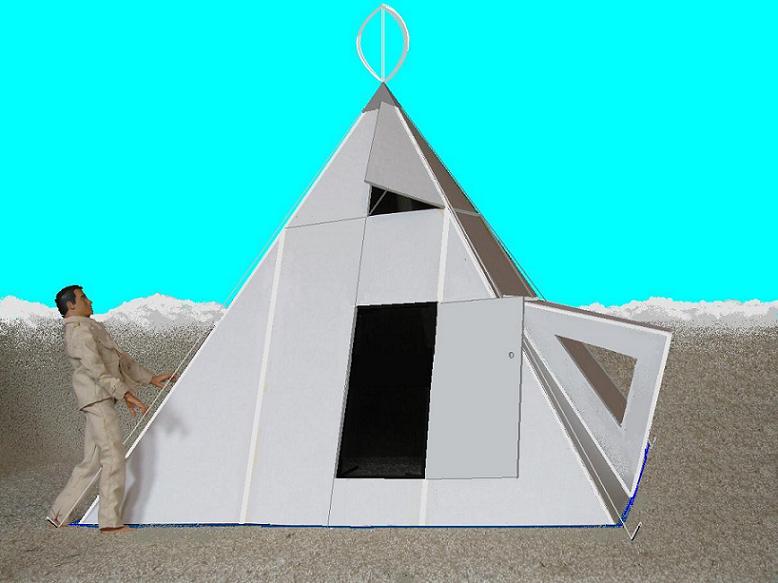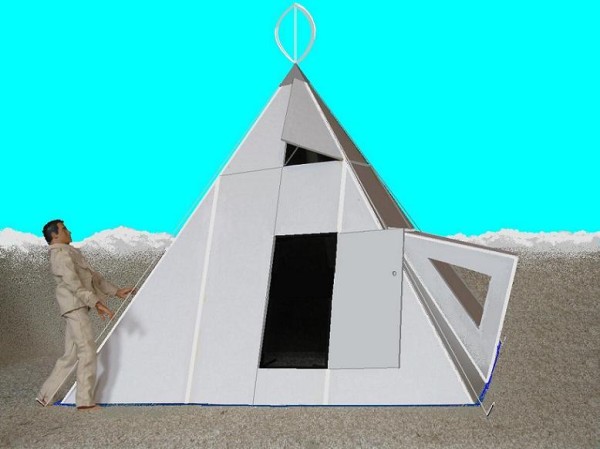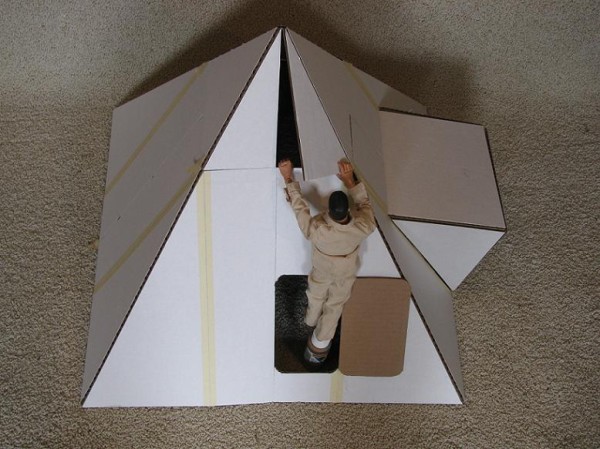Paul Elkins previously share with us his Cadillac of Homeless Shelters and has come up with an idea for an emergency shelter that I though you would enjoy seeing.
This 12′ by 12′ square shelter design was influenced by the designer of the Hexayurt. This will be my 2011 Burningman shelter for my wife and I. It also has shown possibilities as a rapid deployment cold weather Emergency Shelter.
The design consists of 10-one inch thick 4’x8′ foil backed foam insulation panels. Like the Hexayurt, the panels will be supported with tape only. No structural framing should be needed. (I’m keeping my fingers cross) The design also makes for virtually no waist in construction material. The adjoining corners will be mitered for a tight fit, and when stored it will fold like an accordion into a 4’x8’x10″ thick light weight package. Set-up time shouldn’t take too long as only a few seams need to be tapped once it’s unfolded. To secure the structure from high winds, lines from a small aluminum cap will run down to each corner of the shelter.
Shown also is a proposed vertical wind mill connecting to an overhead cooling fan. Possibly a generator too?
Like the orientation of the traditional Native American Tipi, the entry door and smoke hole will face East, plus the smoke hole flaps can be alternated depending on wind direction.
The north facing 4ft wide extension will be an area to sit up against. This is also where the bed is. A small dining table will be to the left of the entrance door. I’m also hoping to squeeze in a small kitchen counter on the South side, possibly having a swing- out opening for more head room.
For a 6 ft tall person there will be a 5′ x 5′ standing area in the center of the shelter. There should be storage galore!
Be sure and visit Paul’s blog to see more of his great ideas and inventions.





Cool! Please send pictures when you build it.
Since GI Joe is building it I’m not surprised it has “virtually no waist”!
LOL @ et!
Honestly, I don’t think this thing will stand up to a high wind situation.
Ditto LOL @ et!!!
Dontcha wish GI Joe would take his tiny little camera and get us some shots of the interior?
I went to his website and I think anything he builds will probably work. He looks like a very talented guy, and has a ton of great ideas.
I’m very intrigued, but also concerned about winds. Even a light wind will be exerting a great deal of force on the structure.
It would be seriously heavier and more expensive, but FRP splash panels bonded to either 1/2 ply or thin aluminum sheet might be sturdier.
But that flies in the face of a cheap emergency shelter. Duct tape is amazing stuff; might actually hold it well as is.
A compromise might be something like 3/4″ 2 lb density Dow foam that is lightly framed with small wood strips and either uses a) FRP spash panels, or b) epoxied fabric.
A good aircraft (ultralight) analog might be the skypup (which I built many years back). You can see what the construction is like on…
http://machnone.com/fuselage.aspx
VERY interesting post, and it gets me to thinking about a portable shower/outhouse facility for deep woods camping.
Thanks!
Not sure it would work in cold weather with snow loads. The snow would slide down and pile up around the bottom, pushing the panels inwards, especially if it was heavy wet snow. Rain should be OK as long as you had a decent floor platform. I like Drue’s shower idea though, might try that one.
My 3rd year design class, had a mini competition at the College of Architecture and Planning, Ball State University, for a survival shelter. My group of 6, designed basically the same structure in th Fall 1983. It was an actual competition, and we had to survive on an Island in Lake Erie, for a very cold October weekend. The pyramid design was definitlely the best looking design and the warmest design, we lost points for the bulkiness of the package prior to construction. Overall it was a great time, I am searching for pictures. We used a plexigass cap, and hung a lantern in it.
I think the tethers he has attached to the top should work fine,if tight and strong. Orient it with a corner towards the prevailing wind. Light snow would add to the insulation factor. Its a modern tee pee after all.
Maybe put it on a bearing plate and turn it into a weather vane (ala aviation tetrahedron)?
Speaking of tee pees, they were staked down with one “rope” from the top straight down the center of the interior. you might try that for high wind.
Great looking new efficient design.